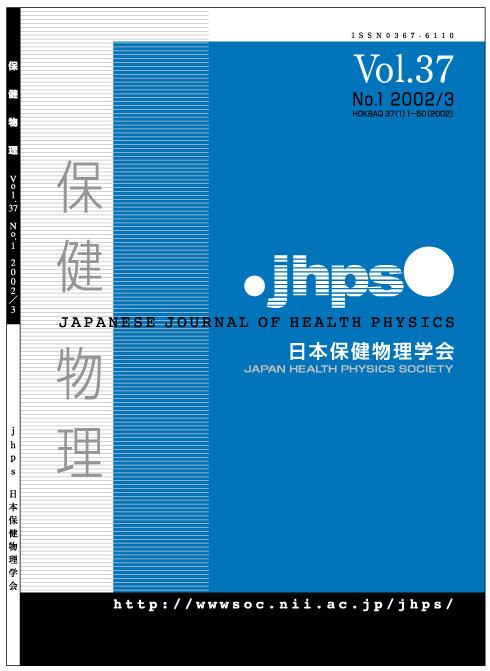巻号一覧

48 巻 (2013)
- 4 号 p. 159-
- 3 号 p. 123-
- 2 号 p. 61-
- 1 号 p. 1-
48 巻, 2 号
選択された号の論文の11件中1~11を表示しています
- |<
- <
- 1
- >
- >|
カラー口絵
-
原稿種別: カラー口絵
2013 年 48 巻 2 号 p. 61
発行日: 2013年
公開日: 2014/03/06
ジャーナル フリーPDF形式でダウンロード (919K) -
原稿種別: カラー口絵
2013 年 48 巻 2 号 p. 61a
発行日: 2013年
公開日: 2014/03/06
ジャーナル フリーPDF形式でダウンロード (919K) -
床次 眞司原稿種別: カラー口絵
2013 年 48 巻 2 号 p. 62
発行日: 2013年
公開日: 2014/03/06
ジャーナル フリーPDF形式でダウンロード (1774K)
巻頭言
-
Jacques LOCHARD原稿種別: Foreword
2013 年 48 巻 2 号 p. 65-66
発行日: 2013年
公開日: 2014/03/06
ジャーナル フリーPDF形式でダウンロード (211K)
話題
-
~除染は, 科学的だけではできない, 人の心にも働きかけを~半澤 隆宏原稿種別: 話題
2013 年 48 巻 2 号 p. 67-72
発行日: 2013年
公開日: 2014/03/06
ジャーナル フリーPDF形式でダウンロード (328K) -
床次 眞司原稿種別: 話題
2013 年 48 巻 2 号 p. 73-78
発行日: 2013年
公開日: 2014/03/06
ジャーナル フリーPDF形式でダウンロード (1894K) -
―日本原子力研究開発機構東海研究開発センターを訪問して―横田 ひろみ, 床次 眞司原稿種別: 話題
2013 年 48 巻 2 号 p. 79-81
発行日: 2013年
公開日: 2014/03/06
ジャーナル フリーPDF形式でダウンロード (331K)
解説
-
藤通 有希, 小佐古 敏荘, 吉田 和生, 浜田 信行原稿種別: 解説
2013 年 48 巻 2 号 p. 86-96
発行日: 2013年
公開日: 2014/03/06
ジャーナル フリーThe International Commission on Radiological Protection (ICRP) has classified radiation cataract as tissue reactions (formerly known as deterministic effects or non-stochastic effects) for which a threshold dose exists, and recommended an equivalent dose limit for the lens of the eye to prevent vision-impairing cataracts. A recommended occupational dose limit has been 150 mSv/year predicated on the threshold of >8 Sv since the 1980 Brighton Statement, but was drastically lowered by the 2011 Seoul Statement to 20 mSv/year, averaged over defined periods of 5 years, with no single year exceeding 50 mSv. Such a new limit was included immediately in the Interim Edition of General Safety Requirements Part 3 of the International Atomic Energy Agency. In contrast, a dose limit of 15 mSv/year for members of the public has not been changed since the 1990 Recommendations. This paper considers the impacts of a new limit focusing on conformity with cancer risk management, the necessity of the public dose limit in planned exposure situations and the occupational dose limit in emergency exposure situations. Potential issues arising from its implementation shall also be discussed especially in terms of the compensation problem and the possibility of exceeding a dose limit in interventional cardiologists.抄録全体を表示PDF形式でダウンロード (525K) -
藤通 有希, 小佐古 敏荘, 吉田 和生, 浜田 信行原稿種別: 解説
2013 年 48 巻 2 号 p. 97-103
発行日: 2013年
公開日: 2014/03/06
ジャーナル フリーRadiation cataract has been classified as tissue reactions (formerly known as deterministic effects or non-stochastic effects) with a threshold dose. In 1984, the International Commission on Radiological Protection (ICRP) suggested the threshold dose of >8 Sv for vision-impairing cataracts in highly fractionated or protracted exposures. Such a threshold was used to recommend an occupational dose limit for the lens of 150 mSv/year in 1990 and 2007, but was reduced to 0.5 Sv in 2011 for all exposure scenarios irrespective of the rate of dose delivery. New threshold was determined on the basis of the limited human evidence, with various hypotheses not supported by the present knowledge of biological mechanisms. Examples of untested hypotheses include: (a) radiation cataract is a tissue reaction; (b) radiation damage to the large number of cells acts as a triggering event for radiation cataract; (c) detectable minor opacities progress into vision-impairing cataracts with time; and (d) the lower the dose, the longer the latency. This paper discusses the issues behind the scientific basis for the new threshold, and provides directions for future epidemiological and biological studies to establish the reasonably modeled dose-response relationship for radiation cataract.抄録全体を表示PDF形式でダウンロード (544K)
資料
-
永岡 美佳, 藤田 博喜, 中野 政尚, 渡辺 均, 住谷 秀一原稿種別: 資料
2013 年 48 巻 2 号 p. 104-113
発行日: 2013年
公開日: 2014/03/06
ジャーナル フリーMonthly deposition samples were collected at the Nuclear Fuel Cycle Engineering Laboratories located about 115 km south of the Fukushima Daiichi Nuclear Power Plant (NPP), and the radioactive nuclides were analyzed. Although radionuclides such as 131I, 129mTe-129Te and 132Te-132I with 134Cs and 137Cs were observed by gamma spectrometry at the early time of the Fukushima Daiichi NPP accident, only 134Cs and 137Cs were detected as of September 2011. The annual depositions of 134Cs and 137Cs were about 19,000 and 17,000 Bq m-2, respectively in March 2011-February 2012 after the accident. Moreover, 90Sr was detected in some samples. Monthly 90Sr deposition in March 2011 was 5.1 Bq m-2 month-1 and then decreased after that. On the other hand, 239, 240Pu concentration was the same level with the concentration before the accident.抄録全体を表示PDF形式でダウンロード (930K)
Radiation Protection in the World
-
立川 博一, 石森 有2013 年 48 巻 2 号 p. 114-120
発行日: 2013年
公開日: 2014/03/06
ジャーナル フリーPDF形式でダウンロード (434K)
- |<
- <
- 1
- >
- >|